#God Guandi
Photo

“Altar in the Chinese Joss-house, San Francisco. A probable illustration of Eastern Glory Temple from Harper’s Weekly, March 25, 1871.
The Eastern Glory Temple of Dupont Street
The “Eastern Glory” Temple (東華廟; canto: “Doong Wah miu;” pinyin: “Donghua miao”) reportedly opened in 1871 possibly at 929 Dupont Street. The Daily Alta California of February 10, 1871, reported that a temple “just completed by the six companies” was located in the third story of a row of buildings “on the west side of Dupont street on the west side of Dupont street, between Washington and Jackson.”
The reporter who had been invited to the inaugural rites at the new temple observed that the temple’s central hall honored “Pak Tie,” one of three gods whose statues were so honored. The temple also venerated in its center hall, Gwan Dai (關帝; pinyin: “Guāndì”), the God of War, and Hung Sing, the God of Water. Other deities were venerated in side rooms.




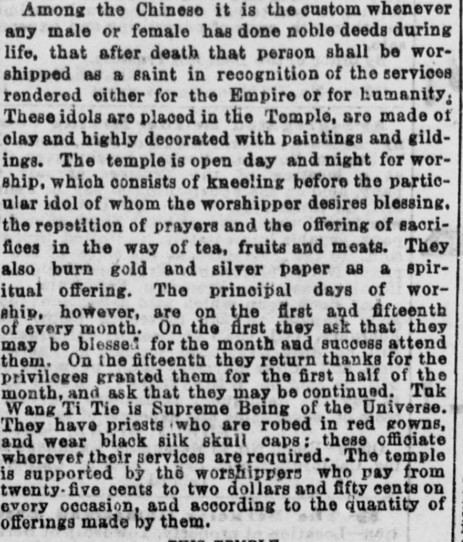



Less than a month later, the Daily Alta California on May 1, 1871, printed a critical letter to the editors from a reader, pointing out numerous inaccuracies in the previous news report. This letter contains the first reference to the temple as the “Tung Wah Min” in reference to its origins in southern China and, perhaps more significant, the poetic inscription which referred to the waves of blessing flowing to the men of eastern Cantonese men. The letter then described the temple’s veneration of “Pak Tie” (北帝; lit. "North Deity;" canto: “Buck Dai”), also known as the “God of the Eastern Peak.”

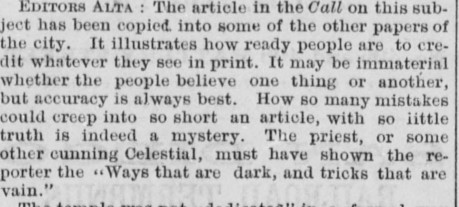






In his superb mapping project of the temples of old San Francisco Chinatown (found here), Peter Romaskiewicz asserts that pioneer photographer Eadweard Muybridge’s photograph “843 -- Chinese Joss House, Guardian of the Temple” c. 1871 was taken in the Eastern Glory Temple. The altar or central shrine shown in the photograph is consistent with the newspaper descriptions.

“843 – Chinese Joss House, Guardian of the Temple” c. 1871 - 1875. Photo by Eadweard Muybridge (from a private collection). The stereograph shows an altar in a temple that is probably the Tung Wah Miu (東華廟; canto: “Doong Wah miu;” pinyin: “Donghua miao”) or the “Eastern Glory” temple to non-Chinese.
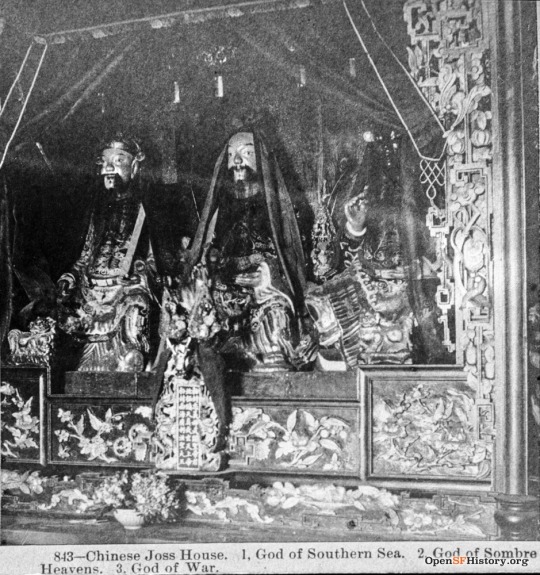
“843 – Chinese Joss House. 1, God of Southern Sea. 2, God of Sombre Heavens. 3. God of War” Detail of the altar of the Eastern Glory Temple, c.1871 - 1875, detail from a photo by Eadweard Muybridge (from the Marilyn Blaisdell collection). In Chinese, the God of Southern Sea would be 南海洪聖大王, Sombre Heaven is 玄武(or 真武)大帝, and the God of War is often ascribed to 關公 (canto: “Gwan Gung”).
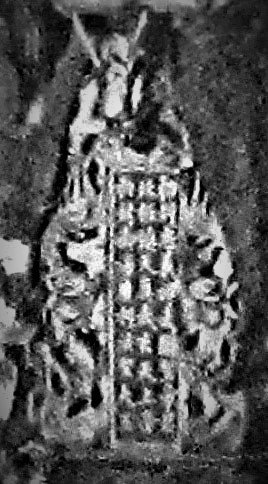
The plaque seen in the Muybridge photo no. 843 presents deity names including “Pak Tie” (canto: “Buk Dai;” pinyin: “Beidi”).
As was the case of Chinatown’s other pre-1906 temples, the Eastern Glory temple was known for its elaborate ceremonies and festivals, which attracted Chinese immigrants from all over San Francisco and beyond. During these events, the temple would be filled with the sounds of traditional Chinese music and the smell of incense, as worshippers prayed and made offerings to the gods.
Assuming that Romaskiewicz accurately located Muybridge’s altar idols image no. 843, the numerical sequence of Muybridge’s other temple images indicates that Muybridge took at least two (and possibly three) photos before entering the Eastern Glory Temple and several other photographs at the same location after capturing image no. 843.
Two photos, 840 and 841, of “menshen” or door gods (文門神; canto: “munh moon sun”) have survived in various public and private collections. The door gods are usually presented in divine pairs, or Shenshu (Chinese: 神荼; Jyutping: “San4 Tou4″).

“840 – Chinese Joss House, Guardian of the Temple” c. 1871. Photo by Eadweard Muybridge (from the Marilyn Blaisdell collection and a stereoview titled “Guardian of the Door” in the collection of California State Library). Based on the negative no. 840, Muybridge probably took this photo of the other entry door to the Eastern Glory Temple before photographing the altar idols and door seen in his images no. 841 and 843. The guardian seen in this image is Shubao (叔寶; canto: “Sook Boh”) , one of two Tang dynasty generals whose image was ordered placed upon gates by the Great Ancestor of the Tang (“Emperor Taizong”).
Since the Tang dynasty, the deified generals Qin Shubao (Chinese: 秦叔寶; Jyutping: “Ceon4 Suk1 Bou2”) and Yuchi Gong (Chinese: 尉遲恭; Jyutping: “Wai3 Ci4 Gung1”) became most ubiquitous as martial door gods (武門神; canto: “moe munh sun;” lit. “military gate gods”). Moreover, the first Chinese in California identified often referred to themselves as “Tohng yahn” (lit. “Tang dynasty people”).

“841 – Chinese Joss House, Guardian of the Temple” c. 1871. Photo by Eadweard Muybridge published as a stereograph by Bradley & Rulofson (from the collection of the Getty Museum). Based on the “841” number, it can be inferred that Muybridge probably took this photo before entering the Eastern Glory Temple and photographing the altar idols seen in his image no. 843. The guardian seen in this image is Yuchi Gong(尉遲恭; canto: “Gwai Chee Gung”), one of two Tang dynasty generals whose image was ordered placed upon gates by the Great Ancestor of the Tang (“Emperor Taizong”).
Based on a comparison of the numerical labeling of the images, and a comparison of the partial signage seen in Muybridge’s photo no. 843, it is possible to connect several images taken of the temple’s resident priest(s) and astrologer outside the entrance.

“844 – Chinese Joss House. Tanist [sic] Priest in full costome.” Photographer Eadweard Muybridge (from the collection of the California State Library).

“Chinese Joss House, Tauist [sic] Priest In Full Costume” c. 1875 (from the collections of the Bancroft Library).

“845 - Chinese Joss House, Astrological Priest”(from the collection of the New York Public Library). This photo appears to have been taken in front of the same building as the photo no. 842 of the Taoist priest.

“846 – Chinese Joss House, Priests discussing Theology.”

“847 – Chinese Joss House. God of the Earth.”
Muybridge’s dogged persistence, and the apparent cooperation of the temple staff, produced an extant photographic record of the Eastern Glory temple provides perhaps the best documentation of the pre-1906 temples in San Francisco Chinatown.
Despite the challenges faced by the Chinese community in San Francisco, including discrimination, poverty, and violence, the Eastern Glory Temple remained a source of strength and resilience. It provided a sense of belonging and identity for the community, and helped to preserve traditional Chinese culture and beliefs in a foreign land.
However, the temple’s days came to an abrupt end in 1906, when a massive earthquake struck San Francisco and destroyed much of Chinatown. The Eastern Glory Temple was among the many buildings that were destroyed in the disaster. Despite its relatively short existence, the Eastern Glory Temple remains an important symbol of the resilience and perseverance of the Chinese community in San Francisco. Today, its legacy lives on through the many temples and cultural institutions that continue to thrive in Chinatown and beyond.
[updated: 2024-5-5]
#Eastern Glory Temple#929 Dupont St.#San Francisco Chinatown#Chinese joss house#Eadweard Muybridge#Beidi#Guandi#Daily Alta California#door gods#Qin Shubao#Yuchi Gong
2 notes
·
View notes
Text










Homelike Ambience in the Martial Deity Temple
Unexpectedly stunning architecture of the rural Guandi temple (關帝廟), the largest in the Chinese countryside. During heat waves, the elderly uses its huge lobby to relax and socialize. Like many rural temples, this one is distinguished by a special homelike heartiness.
Located in Qiangxia village (牆下村), Xia county, Yuncheng, Shanxi, the temple was built to honor Guan Yu during the Yuan dynasty, but evolved and expanded many times in the subsequent Ming and Qing eras.
Originally Marquis Zhuangmou (壯繆侯), Guan Yu in Chinese folk religion achieved the status of Emperor Guan (Guandi 關帝) over the centuries. By the Sui dynasty (581–618), he was officially deified and became part of the motley pantheon as a martial god. Later, the cult of Guan Yu reached the international level and can now be traced in Vietnam, Korea, Singapore, and Japan.
Photo: ©大梁趙孟橘
#ancient china#chinese culture#chinese architecture#guan yu#qing dynasty#yuan dynasty#ming dynasty#wooden architecture#wooden buildings#wooden interior#old china#chinese customs#taoism#taoist#chinese folk religion#chinese temple#religious art#temple architecture#countryside#wood aesthetic#wood art
94 notes
·
View notes
Video
<strong>Figur des Kriegs- und Reichtumsgottes Guandi (Figure of the God of War and Wealth) <a href="https://www.flickr.com/photos/hen-magonza/">by HEN-Magonza</a></strong>
Figur des Kriegs- und Reichtumsgottes Guandi Polychrom glasiertes Steinzeug China, Ming-Dynastie, 16. Jh. n. Chr.
Figure of the God of War and Wealth Stoneware with polycrhome glaze Chine, Ming Dynasty, 16the century AC
#Liebieghaus#Frankfurt#Hessen#Hesse#Deutschland#chinesische Kunst#Chinese Art#Gott Guandi#God Guandi#Frankfurt am Main
2 notes
·
View notes
Photo
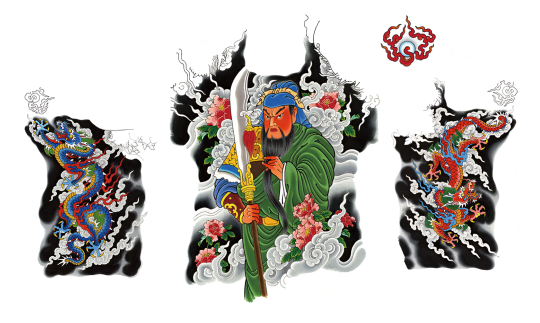
李文海, Lee Wen Hai
関羽と龍 - Guan Yu and Dragons
Type: Full
Note: Lee's back and chest tattoo sections are never revealed in game. Only the two dragons are ever fully visable, though in the mahjong parlor the edge of the pearl on his chest can be seen.
Features:
Guan Yu - Also known as Guandi, Guan Gong, or Wudi. A Chinese historical figure who was canonized as a god of war during the Ming dynasty. He appears as a character in the famous Chinese novel "Romance of the Three Kingdoms." He is a heroic figure, whose control over evil spirits is so great that it is believed even actors who play his part in dramas share his power over demons.
One of China’s best-known stories tells how he became one of the Three Brothers of the Peach Orchard. Liu Bei, a maker of straw sandals, intervened in a fight that was brewing between Guan Yu and a prosperous butcher named Zhang Fei. The three became friends and swore oaths of undying loyalty that they faithfully observed until death.
Another story tells of Guan Yu coming to the rescue of a young girl abducted by a magistrate. Guan Yu killed the man and after fleeing for his life, came upon a guarded barrier. Suddenly his face changed to a reddish hue, and Guan Yu was able to pass unrecognized. He is often depicted with red skin in reference to this story.
Imperial Dragons - Eastern dragons are powerful and fearsome, but mostly benevolent creatures known to protect temples and help and reward virtuous people. In China, they are associated with the element of wood, but also control weather and water.
The Imperial Chinese Dragon is identifiable by its 5-clawed feet (as opposed to the normal Chinese dragon's 4 claws or Japanese 3 claws). Dragons represent the emperor and how a good ruler must be just and look out for the good of their subjects.
Red - energy, vitality, heat, and power. In China red is a lucky color associated with happiness, celebration and fertility. It is the color of the fire element, and is said to ward off evil.
Blue - calmness, stability, purity, cleanliness, passivity and fidelity. In China Blue is associated with the wood element and also symbolizes spring, immortality and advancement. The Blue/Azure dragon is the ruler of the eastern sky in both Japan and China.
Pearl - Eastern Dragons are often depicted carrying a pearl, sometimes clutched in its claws or beneath the neck. While the exact origin of the pearl is unknown, it has come to represent the dragon’s authority, the moon, the sun, and control of water.
Peonies - good fortune, wealth, nobility, bravery, and honor. Red peonies are associated with Imperial China and signify authority.
Clouds - The heavens, the realm of the gods and admiration of nature.
Flames - Passion, Energy, desire, movement
#wen hai lee#yakuza#ryu ga gotoku#yakuza games#yakuza 0#tattoos#irezumi#dragon#peonies#clouds#flames#guan yu#like a dragon
55 notes
·
View notes
Text
New Fiction 2022 - March
The Bible, Douay-Rheims, Complete - "Deuteronomy" ed. Richard Challoner (1752)
More repetition of mostly the same rules and laws from Numbers and Leviticus, but now we see just how wrathful God gets about his flock going astray. He knew exactly what would happen and fully expected that the Israelites would gripe and fall in with the false idols of the natives of the promised lands. It’s basically a demonic horror villain promising all the ways he’s going to make you suffer. I just feel bad for Moses, who tried real hard to keep a society of people in good standing with the Lord but they were just not gonna have it.
The Bible, Douay-Rheims, Complete - "Josue" ed. Richard Challoner (1752)
I gotta say, I look forward to these shorter books after the long stretches. Josue is believed to have been written by the man himself except for a few final verses added on after his death, an interesting sidenote in this revision. In content, it's mostly another inventory of the people of Israel and Josue's role as executor of God's estate after the Israelites swept through and killed most of the natives. The Old Testament seems to be mostly rules, inventory, and promises of horrible pain and death.
The Fall of Terok Nor by Judith & Garfield Reeves-Stevens (2000)
This first part of a trilogy delivered on classic characters in their element, though the authors made some weird choices around characters expressing their attractions and it made some dialogue and behaviors feel out of character.
The War of the Prophets by Judith & Garfield Reeves-Stevens (2000)
Then the second part of the trilogy goes off-the-wall ape-shit in its plot. It really is a mind-boggling series of events with some especially gruesome moments of violence. Not bad, per se, but taking the characters out of their element really threw me for a loop. It reminds me of many a middle entry that just isn’t particularly pleasant because bad things are happening to characters I know and it won’t be resolved until the third part.
Inferno by Judith & Garfield Reeves-Stevens (2000)
The time travel element hits hard in the ending of this trilogy of novels, and although they get long-winded at times, it’s fun when characters are trying to use technobabble to explain time travel mechanics and paradoxes woven into the many wild layers of shenanigans. But this one ends the horrifying stuff that happens in the previous book and brings everyone back to Deep Space Nine, which I very much appreciated. It’s maybe too neat an ending considering everything they experience, but it’s also where they needed to be since this all takes place in the latter part of the sixth season of the show.
"Giraffes Explained" by Tim Andraka (2022)
Ah, I knew there had to be a logical explanation.
"I have been hired to clean the wizard tower" by tart (2022)
Tough job, but it’s a living.
"白圈 White Ring" by Woshibai & trans. Guandi Wu (2022)
What an immensely confusing experience is childhood.
"Platformer Practice" dev. Itizso (2020)
Love a good girder hop.
Fox's Peter Pan & the Pirates dev. & pub. Tiger Electronics (1990)
I have never completed a LCD handheld game and I don’t know that I’ll ever achieve this again.
The Young Indiana Jones Chronicles dev. Chris Gray Enterprises & pub. Jaleco (1992)
Nintendo hard still applies to this game from quite late in the life of the NES, but it may be the most mechanically fun of the various games based on Young Indiana Jones. I’m still wondering if this deserves more praise than it seemed to receive in its time.
Instruments of Chaos Starring Young Indiana Jones dev. Brian A. Rice, Waterman Design & pub. Sega (1994)
Whereas this second 2D platformer tried for some technical feats and really just falls flat with its bonkers physics and controls. The very long list of testers guarantees that the issues were noted and this was the best they could do in what I can only assume was a very short development period.
The Adventures of Young Indiana Jones: Revolution dev. Riverdeep, Asylum Entertainment & pub. LucasArts (2007)
I was trying to remember if Flash was still relevant for game development in 2007, and I think it was on its way out then. I still harbor some nostalgia for the vector visuals.
The Adventures of Young Indiana Jones: Special Delivery dev. Riverdeep, Asylum Entertainment & pub. LucasArts (2007)
Someone decided the first game was too easy and cranked up the difficulty of the dexterity challenges, which is an odd choice for slow-paced games based around adequately preparing for long journeys a la The Oregon Trail and answering historical trivia questions.
The Adventures of Young Indiana Jones: Hunting for Treasure dev. Riverdeep, Asylum Entertainment & pub. LucasArts (2008)
While mechanically these simple dialogue and mini game assemblages aren’t very interesting, their edutainment factor is impressive. I really did learn some history each time a character asked me for some obscure detail about war machines or tribal rituals.
Robot Carnival - "Opening" dir. Katsuhiro Otomo & Atsuko Fukushima (1987)
An opening to behold.
Robot Carnival - "Franken's Gears" dir. Koji Morimoto (1987)
Animating any mechanical object must be someone’s special hell.
Robot Carnival - "Star Light Angel" dir. Hiroyuki Kitazume (1987)
Journey with me.
Robot Carnival - "Deprive" dir. Hidetoshi Ōmori (1987)
If you fight and you fight then you will only fight.
Robot Carnival - "Cloud" dir. Manabu Ōhashi (1987)
Continuation is the curse we fail to acknowledge.
The Batman dir. Matt Reeves (2022)
A freak indeed.
Gangubai Kathiawadi dir. Sanjay Leela Bhansali (2022)
Look out for the ones beside you.
Compartment No. 6 dir. Juho Kuosmanen (2021)
The darkness of the everyday makes me more apprehensive than the terrors we avoid.
Umma dir. Iris K. Shim (2022)
A slap in the face of this wayward child.
The Outfit dir. Graham Moore (2022)
A little less polished and this could’ve really hit hard.
X dir. Ti West (2022)
When you’re alone and alone and alone, your world is the only and the others don’t belong.
Sweet Smell of Success dir. Alexander Mackendrick (1957)
There’s no stopping what can’t be stopped.
The Changeling dir. Peter Medak (1980)
A certain kind of horror hero who doesn’t acknowledge the fear.
Re-Animator dir. Brian Yuzna & Stuart Gordon (1985)
This insistence on forever.
Everything Everywhere All At Once dir. Daniels (2022)
The other you pokes you on the shoulder.
La Mujer Murcielago dir. René Cardona (1968)
Yes! The existence of the thing demands its preservation.
The Lost City dir. Aaron Nee & Adam Nee (2022)
It always ends inside the tomb, don’t it?
Infinite Storm dir. Malgorzata Szumowska (2022)
What is the weight of a life to you? Does it ever get too heavy?
Mighty Max (1993-1994)
I always remembered the final episode as a particularly clever way to end a syndicated animated show that would mostly be watched out of order. And considering that this show was made to advertise toys to kids, it’s a surprisingly mature and dark look at the ol’ hero’s journey.
#new fiction#2022#mighty max#infinite storm#the lost city#la mujer murcielago#everything everywhere all at once#re-animator#the changeling#sweet smell of success#x#the outfit#umma#compartment no. 6#gangubai kathiawadi#the batman#robot carnival#young indiana jones#deep space nine#star trek#the bible
2 notes
·
View notes
Photo

Guandi, Daoist God of War, porcelain with famille verte enamels and human hair, ca. 1700, China, Qing dynasty, Kangxi reign
Taft Museum of Art, Cincinnati
4 notes
·
View notes
Text
RULES. Repost, do not reblog ! Tag 10 ! Good luck !
Tagged by: @thexkestrel
Tagging: The person who is reading this now :D
BASICS.
FULL NAME : Samuel Alexander
NICKNAME/S : Sam, Sammy, Buckethead, Chum bucket, Chummy, Space Boy, Darth Nova
AGE : 15
BIRTHDAY : ???
ETHNIC GROUP : Latino/Hispanic
NATIONALITY : Hispanic-American
LANGUAGE/S : English, some Spanish
SEXUAL ORIENTATION : Bisexual
ROMANTIC ORIENTATION : Biromantic
RELATIONSHIP STATUS : Single (verse dependent)
CLASS : Lower Class
HOME TOWN / AREA : Carefree, Arizona
CURRENT HOME : Small apartment in Carefree
PROFESSION : High School Student, Space Cop, Superhero
PHYSICAL.
HAIR : Black
EYES : Blue
NOSE : Roman
FACE : Diamond
LIPS : Sharp
COMPLEXION : Medium toned to tan.
BLEMISHES : The occasional zit
SCARS : One on his upper arm on his bicep from a blaster shot. Large burn scars from where he had a wound cauterized to avoid bleeding to death on his side.
TATTOOS : None
PIERCINGS: None
HEIGHT : 5′6″
WEIGHT : 140 lbs
BUILD : Small, lithe, thin, but defined muscles
FEATURES : High cheekbones and defined jaw. Skin tone changes depending on the time of year.
ALLERGIES : None
USUAL HAIR STYLE : Usually spiked up and messy. Shortish hair.
USUAL FACE LOOK : Typically is smiling??
USUAL CLOTHING : A T-shirt and some shorts. Something cool, since Arizona is hot.
PSYCHOLOGY.
FEAR/S : Failure, death, being unable to protect those he cares about, losing someone he loves
ASPIRATION/S : To graduate high school, to help people
POSITIVE TRAITS : Compassionate, hopeful, fiercely protective, clever, witty, strong-willed
NEGATIVE TRAITS : Self-doubting, trust issues, short-tempered, sarcastic, impulsive, secretive
ZODIAC : ???
TEMPERAMENT : Hotheaded, impatient, in general. He is prone to yelling at his helmet when things get to be too much. Threatening, endangering, or insulting his family (including his father) or Earth is the fastest way to provoke him.
SOUL TYPE / S : Artisan
ANIMALS : A bird. Like a finch.
VICE HABIT/S : Drinking to excess, lying/dishonesty/betrayal
FAITH : Agnostic, possibly Catholic
GHOSTS ? : Yes
AFTERLIFE ? : Possible.
REINCARNATION ? : Possible.
ALIENS ? : He fights them frequently
POLITICAL ALIGNMENT : None, really.
ECONOMIC PREFERENCE : Enough to support his family and buy back their old house (which they got evicted from)
SOCIOPOLITICAL POSITION : Not very influential. However his alter-ego Nova is popular on social media with the Champions team.
EDUCATION LEVEL : Some high school. And whatever he has picked up from space or working with other heroes.
FAMILY.
FATHER : Jesse Alexander
MOTHER : Eva Alexander
SIBLINGS : Kaelynn Alexander (younger sister),
EXTENDED FAMILY : Abuelita (grandmother), Sergio (uncle), Silvio (uncle)
NAME MEANING/S : Samuel means “asked of God” or “heard God” and is of Hebrew origin. Alexander means “defender of men” and is of Greek origin.
HISTORICAL CONNECTION ? : I doubt there is any.
FAVOURITES.
DEITY : None.
MONTH : December
SEASON : Fall
PLACE : The Moon or space
WEATHER : Gentle rain
SOUND : Old music
SCENT/S : Cookies or sweets baking
TASTE/S : Spicy foods
FEEL/S : Anything warm, soft, and comforting like being held or wrapped tightly in a blanket.
ANIMAL/S : Dogs
NUMBER : 7
COLOUR : Orange
EXTRA.
TALENTS : Art, writing, cooking
BAD AT : Lying
TURN ONS : Independence, intelligence, kindness
TURN OFFS : Cruelty, dishonesty
HOBBIES : Drawing, writing, cooking, adventuring out in space, stopping baddies, babysitting his little sister
TROPES : Berserk Button, Big Brother Instinct, The Unfavorite, Mixed Ancestry, Born Unlucky (no, seriously. his bad luck can rival Peter Parker’s with ease), Half-Human Hybrid (although not confirmed but hinted at), Deadpan Snarker, and probably some others
AESTHETIC TAGS : reaching for the 𝓼 𝓽 𝓪 𝓻 𝓼 (anesthetic)
FC INFO.
MAIN FC/S : Shawn Mendes (Until I can find one I like better)
ALT FC/S : None
OLDER FC/S : David Guandy (Again, until I can find a better one)
YOUNGER FC/S : None
VOICE CLAIM/S : Whoever does his voice on Avengers Academy
0 notes
Photo

LOT 145 - A RARE GILT BRONZE FIGURE OF GUANDI 明铜鎏金关帝像 The God of war is shown seated, wearing a long robe incised with dragon in medallions and armor detailed with a tiger head epaulet His right hand holding his long beard seems to be in a teaching gesture (Buddhist mudra) The left hand resting on his knee showing power and tranquility The face of the God expressing serenity and spirit fortitude China, 17th century, late Ming Dynasty Height: 15,5 cm 关帝头戴冠帽,眉眼聚神,美髯直垂胸前,面容肃穆生威;身着铠甲、战袍在腰前有结有龙纹装饰,袖袂迎风飘扬;右手轻抚胡须,左手直插腰际,双腿平放垂坐,形象威武。关帝信仰自宋元以来深受推崇,奉祀于关帝庙,成为除妖降魔的天神之一。关公,名羽,字云长,“公”为封号,为三国时期蜀汉名将关羽,由于其忠诚和武勇的形象,逐渐被后人神化,明朝万历年间封帝,故民间敬称关帝。清代时被奉为“忠义神武灵佑仁勇威显关圣大帝”,崇为“武圣”,与“文圣”孔子齐名。 GUANDI also known as GUAN YU was the renowned general GUAN GONG during the period of the three kingdoms. Born 160 ad JC in Yuncheng dead 220 ad JC in Xiangyang. Today GUANDI is worshipped as a guardian deity by Taoist and Buddhist @veritasartauctioneers #art #auction #asianart #guandi #giltbronze #china #17thcentury #mingdynasty
0 notes
Video
vimeo
A Rare Gilt Bronze Figure of Guandi from Veritas Art Auctioneers on Vimeo.
The God of war is shown seated ,wearing a long robe incised with dragon in medallions and armour detailed with a tiger head epaulet.
His right hand holding his long beard seems to be in a teaching gesture (buddhist mudra).
The left hand resting on his knee showing power and tranquility.
The face of the god expressing serenity and spirit fortitude.
GUANDI also known as GUAN YU was the renowned general GUAN GONG during the period of the three kingdoms.
Born 160 ad JC in Yuncheng dead 220 ad JC in Xiangyang.
Today GUANDI is worshipped as a guardian deity by taoist and buddhist .
China, 17th century late Ming Dynasty.
Hight: 15,5 cm
0 notes
